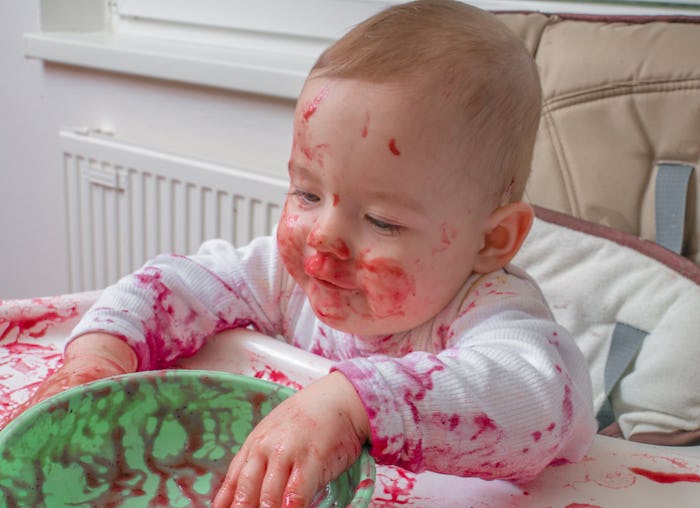Life

Here's Why You Should Go Ahead & Let Your Baby Make A Big Mess At Mealtime
There are a thousand bibs, bowls, and no-spill cups out there designed to keep kids from getting messy at mealtime, and yet they always seem to find a way. But it turns out there are good reasons why you should let your baby make a mess when they eat, according to experts. It helps them learn about the world around them, gets them to eat more types of food, and even helps expand their vocabulary.
“Kids who are permitted to get their hands in food are more likely to eat it," psychologist Stephanie Kinnare Ph.D. tells Romper. "This is largely because the foods become familiar to the child when introduced in a fun, go-ahead, dive-in atmosphere. This means more fruits and vegetables in that belly! But don’t be alarmed if the food doesn’t go to the tummy right away; it may take several encounters with the food before it makes its way into the belly.”
That makes sense — everything else babies pick up goes in their mouths, so why not let them get handsy with their breakfast, lunch, and dinner? It’s how they examine and learn about things in their environment. Just like sticking a toe in the pool to see if the water is too hot or cold before diving in, babies and toddlers use touch to gauge food’s safety.
“As the child learns to touch and feel the food, this touch sends a signal to the brain that this food is wet, dry, sticky, or mushy,” feeding specialist and occupational therapist Judy Delaware OTR/L, CLC, tells Romper. “We learn through our sense of touch what we consider to be safe or otherwise. When we allow children to explore food through their hands, arms, faces, and yes, feet, they learn what to expect of the food and what feels good to them. Messy and purposeful play with food is a very important part of development. It’s a short-term issue with the parent portion of the mess, with a long-term investment in your child’s eating skills.”
But hands-on, oops-my-breakfast-exploded-style eating isn’t just good for babies’ understanding of food physics. Studies show it develops their growing minds in unexpected ways, too, says Kinnare.
“One study revealed that messy eating even increases word knowledge in toddlers. In a nutshell, the authors found that messy highchair eaters who were presented with non-solid foods that were assigned fake names did better at identifying the names of the foods than eaters who were presented with the foods in other contexts,” she explains. “Exploring foods in a highchair is not only the best learning environment for kids, but also gives parents the best chance of avoiding those dreaded food-inspired art projects on the carpet. As such, confining messy eating to highchairs is a win-win for parents and young children.”
All the interactions around food are key to development too. Learning to ask for more, getting into a mealtime routine... these actually have far-reaching effects on your child’s brain.
“Eating works on a variety of developmental skills, including social-emotional, communication, cognitive, fine and gross motor, and of course, the skill of adaptive or self-help skills,” says Delaware. “The social-emotional area includes engaging in modeling, imitation, and social engagement. Communication skills might also include babbling and single word requests, like requesting more of a certain food. Fine and gross motor skills are facilitated by learning to grasp and release foods, utensils, and cups.”
Parents who notice their child avoiding certain textures of their food may worry about the association between texture aversion and autism, as explained on Autism Speaks, but experts agree it’s not something to be concerned about right away. In fact, most kids start out not enjoying certain textures.
“It’s also normal for kids to avoid, and even gag at, textured foods at first,” says Kinnare. “If by one year old a baby is still rejecting lumpy and textured foods, then the pediatrician should be consulted to see if there’s any developmental issue occurring. However, most of the time, by mixing increasingly greater and greater amounts of textured foods into pureed foods, most babies are on their way to healthy eating.”
That said, while some kids just need to progress at their own speed with learning to eat mashed potatoes or smoothie bowls, texture aversion is something to keep an eye on. Your pediatrician can guide you to the right specialists if your kiddo needs some extra support.
“If a child is showing signs that the touch of food to their hands isn’t safe, even after numerous exposures, it’s something not to ignore,” says Delaware. “Talk to your child’s pediatrician about this and request a referral to an occupational therapist to evaluate your child’s sensory processing system. Try not to force what you think is safe onto your child’s hands and body as a child might need to progress at a different pace than you realize. Trust your instincts when you see something that does not seem right when it comes to your child’s sense of touch and getting messy.”
Experts:
Stephanie Kinnare, Ph.D., psychologist at Wolfson Children’s Center for Behavioral Health in Jacksonville, Florida
Judy Delaware OTR/L, CLC, co-founder and feeding specialist at Feeding Littles LLC
This article was originally published on